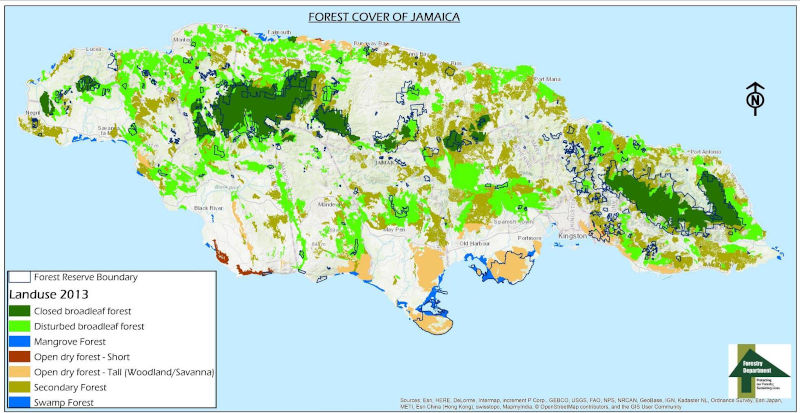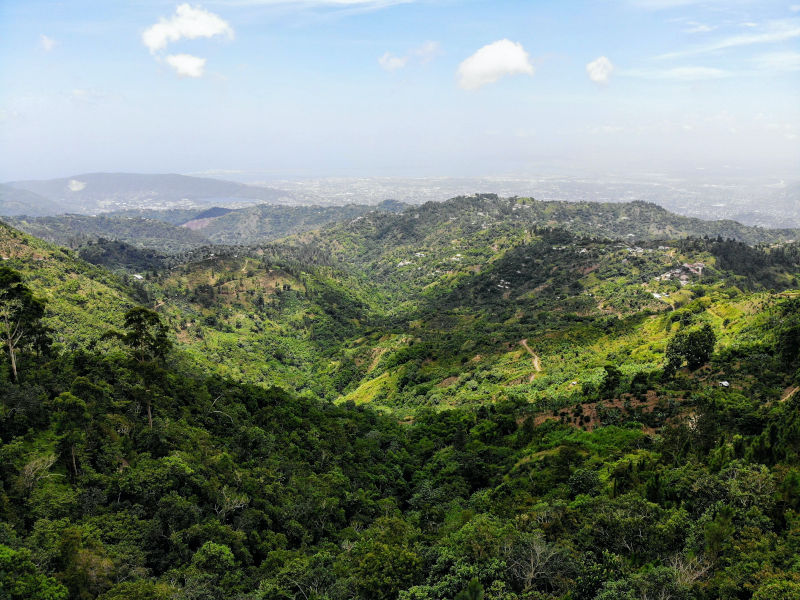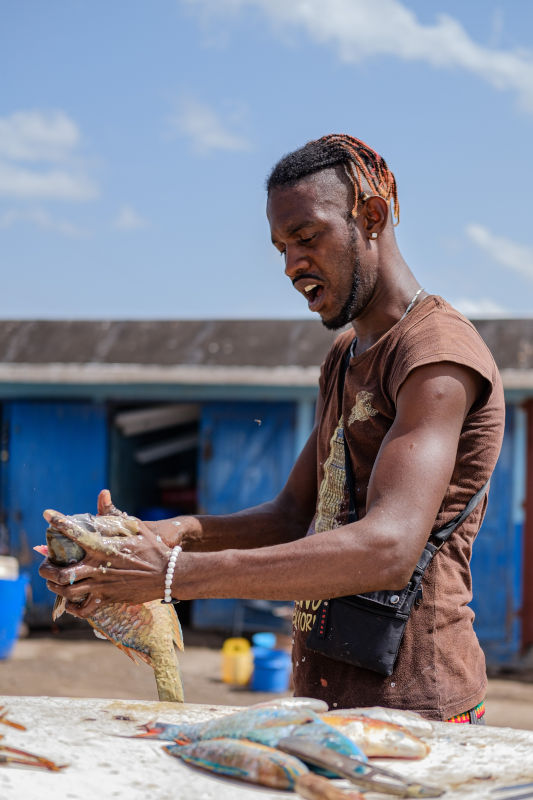Jamaica (18°15’ N, 77°20’ W) is the largest island in the English-speaking Caribbean and third largest island in the region overall. The population of this Small Island Developing State (SIDS), as classified under the Accelerated Modality of Action (SAMOA Pathway), was 2,734,100 at the end of 2019 with an average annual population growth rate of 0.1% (PIOJ, 2020). Approximately 56% of the population live in urban areas (World Bank, 2018) and 82% live within 5 km of the coast.

The island's name is derived from the Arawak word ‘Xaymaca’, which translates to "land of wood and water." With a total landmass of 10,991 square kilometres (4,240 sq. ml.), Jamaica is mountainous, characterised by a central ridge of mountains and hills – the highest point being the Blue Mountain Peak at over 2,256 metres (7,402 feet) – interior valleys and limestone plateaus, and flat or gently sloping coastal plains. In 2020, forests represented 55% (~593,000 ha) of total land area (United Nations, 2020). Jamaica is subdivided into 10 major hydrological basins and has more than 120 rivers.
Located within the Atlantic Hurricane Belt, Jamaica experiences a mainly tropical climate with temperatures at the coast ranging from 22–34°C. Its most important climatic influences are the Northeast Trade Winds and its orographic features (GOJ, 2000). Mean annual precipitation from 1991-2020 was 2,250.99 mm. The island is one of 30 nations and territories that lies within the Caribbean Islands biodiversity hotspot, an archipelago of habitat-rich tropical and semi-tropical islands stretching across nearly 4 million square kilometres of ocean and featuring rich biodiversity and endemism.

Relying heavily on the country’s rich natural resources and ecosystems, Jamaica’s economic and social sustainability support the main industries of agriculture, tourism, manufacturing, and mining and quarrying, and provide a range of environmental services including freshwater supply (PIOJ, 2015). An upper middle-income country, Jamaica’s GDP grew by an average of 0.8% annually between 2013 and 2019 before sharply dropping due to the global pandemic in 2020 (IMF, 2019). Prior to the pandemic, the tourism industry accounted for approximately 28% of GDP and the majority of foreign exchange earnings. Agriculture, forestry and fishing added over USD 1 billion of value to the Jamaican economy in 2019, representing about 7% of national GDP - almost double the Caribbean average (World Bank).
Jamaica is a constitutional monarchy with Queen Elizabeth II as head of state, represented in the country by a Governor-General. The country is a parliamentary democracy with a bicameral legislature and party system, based on universal adult suffrage. The most recent parliamentary elections took place on 3 September 2020. (UNCT, Jamaica 2021). Jamaica is a member of the Caribbean Community (CARICOM), Organisation of American States (OAS), Association of Caribbean States (ACS), and belongs to the Alliance of Small Island States (AOSIS) (CMCA, 2021).
Vision 2030 Jamaica: National Development Plan represents the country’s commitment to good governance, democratic principles, and participation of the citizenry in national development. The plan provides a framework for Jamaica to achieve sustainability and the sustainable development goals through the integration of the social, economic, and environmental dimensions.
Jamaica faces several social and economic development challenges including a high public debt, high levels of violence and organised crime, and high poverty rate. The most significant environmental issues in Jamaica are the effects of climate change; vulnerability to natural hazards including landslides, hurricanes, floods, droughts, and earthquakes; pollution; and overexploitation of natural resources. Of note are the issues of deforestation; pollution of coastal waters by industrial waste, sewage, and oil spills; damage to coral reefs; and air pollution in cities. These environmental challenges already impact natural resources, the economy, and social well-being (PIOJ, 2018).

The Government has taken steps to ratify or accede to a number of Multilateral Environmental Agreements and Conventions. The National Environment and Planning Agency (NEPA) is the primary government agency responsible for managing the country’s natural resources and environment. Other ministries and agencies that manage the environment include the Forestry Department, Fisheries Division, Jamaica National Heritage Trust, Ministry of Health, Water Resources Authority, Jamaica Bauxite Institute, National Land Agency, and the National Solid Waste Management Authority.
Despite participating in a range of environmental policies and agreements as well as integrating good governance strategies, Jamaica faces several challenges when it comes to environmental governance. These include a weak participatory framework for decision-making, lack of R&D and access to data, lack of financial resources, corruption and deficiencies in legal authority and institutional capacity. The latter often results from lack of or outdated regulatory legislative frameworks, as well as legislative uncertainties (UNEP, 2016).
Sources:
- World Bank, Open Data (2018) https://data.worldbank.org/indicator/SP.URB.TOTL.IN.ZS?locations=JM
- Government of Jamaica (2000), Jamaica's Initial National Communication to the United Nations Framework Convention on Climate Change
- Planning Institute of Jamaica (PIOJ) (2015), Medium Term Socioeconomic Policy Framework 2015 - 2018
- Planning Institute of Jamaica (2018), Economic and Social Survey Jamaica -2017
- Planning Institute of Jamaica. (2020), Economic and Social Survey of Jamaica 2019.
- PIOJ (2009), Vision 2030 Jamaica: National Development Plan, https://www.vision2030.gov.jm/wp-content/uploads/sites/2/2021/04/vision…
- UNEP 2016. GEO-6 Regional Assessment for Latin America and the Caribbean. United Nations Environment Programme, Nairobi, Kenya. https://www.unenvironment.org/resources/assessment/geo-6-regional-asses…
- UNCT, Jamaica (2021), United Nations Common Country Analysis: Jamaica 2020, https://jamaica.un.org/en/126271-united-nations-common-country-analysis…
- United Nations (2020d), SDG Indicators - United Nations Global SDG Database, https://unstats.un.org/sdgs/indicators/database/, accessed 19 November 2021.
- IMF (International Monetary Fund) (2019), Jamaica: Sixth Review Under the Stand-By Arrangements Press Release; Staff Report; and Statement by the Executive Direct for Jamaica, https://www.imf.org/en/Publications/CR/Issues/2019/11/07/Jamaica-Sixth-…
- United Nations Caribbean (2021), Caribbean Common Multi-Country Analysis 2021, https://jamaica.un.org/sites/default/files/2021-08/CMCA%202021.pdf
